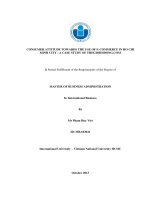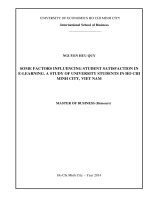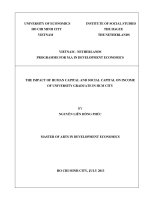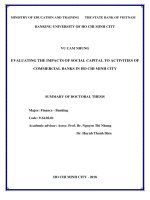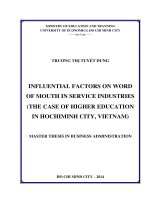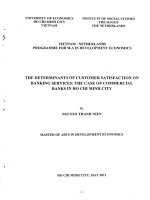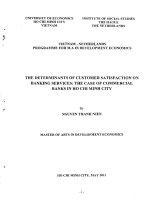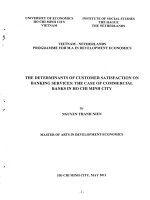(Luận văn) the impact of human capital and social capital on income of university graduate in ho chi minh city
Bạn đang xem bản rút gọn của tài liệu. Xem và tải ngay bản đầy đủ của tài liệu tại đây (1.18 MB, 80 trang )
t
to
ng
UNIVERSITY OF ECONOMICS
INSTITUTE OF SOCIAL STUDIES
hi
HO CHI MINH CITY
THE HAGUE
ep
do
VIETNAM
THE NETHERLANDS
w
n
lo
ad
VIETNAM - NETHERLANDS
y
th
ju
PROGRAMME FOR M.A IN DEVELOPMENT ECONOMICS
yi
pl
n
ua
al
n
va
THE IMPACT OF HUMAN CAPITAL AND SOCIAL CAPITAL ON INCOME
ll
fu
OF UNIVERSITY GRADUATE IN HCM CITY
oi
m
at
nh
z
z
BY
k
jm
ht
vb
NGUYỄN LIÊN HỒNG PHÚC
l.c
ai
gm
om
MASTER OF ARTS IN DEVELOPMENT ECONOMICS
an
Lu
n
va
ey
t
re
th
HO CHI MINH CITY, JULY 2013
t
to
ng
hi
INSTITUTE OF SOCIAL STUDIES
HO CHI MINH CITY
THE HAGUE
ep
UNIVERSITY OF ECONOMICS
do
w
VIETNAM
THE NETHERLANDS
n
lo
ad
y
th
ju
VIETNAM - NETHERLANDS
yi
PROGRAMME FOR M.A IN DEVELOPMENT ECONOMICS
pl
n
ua
al
n
va
THE IMPACT OF HUMAN CAPITAL AND SOCIAL CAPITAL ON INCOME
ll
fu
OF UNIVERSITY GRADUATE IN HCM CITY
oi
m
nh
at
A thesis submitted in partial fulfilment of the requirements for the degree of
z
z
MASTER OF ARTS IN DEVELOPMENT ECONOMICS
k
jm
ht
vb
om
l.c
ai
NGUYỄN LIÊN HỒNG PHÚC
gm
By
n
va
NGUYỄN VĂN PHƯƠNG
an
Lu
Academic Supervisor:
ey
t
re
th
HO CHI MINH CITY, JULY 2013
t
to
ng
hi
ep
Contents
do
ACKNOWLEDGEMENT ......................................................................................... iii
w
ABTRACT ................................................................................................................. iv
n
lo
ad
CHAPTER 1: INTRODUCTION: .............................................................................. 1
y
th
1.1 Problem Statement ............................................................................................. 1
ju
yi
1.2 Research Objective ............................................................................................ 2
pl
ua
al
1.3 Research Question ............................................................................................. 2
n
1.4 Research Methodology ...................................................................................... 3
va
n
CHAPTER 2: LITERATURE REVIEW .................................................................... 4
fu
ll
2.1 Social capital and status attainment theory........................................................ 4
oi
m
at
nh
2.2 Human capital and status attainment theory ...................................................... 6
2.3 Measurement of human capital ........................................................................ 11
z
z
ht
vb
2.4 Measurement of social capital ......................................................................... 13
jm
2.5 Relationship between human capital and social capital .................................. 17
k
CHAPTER THREE: METHODOLOGY ................................................................. 20
gm
l.c
ai
3.1 Introduction ...................................................................................................... 20
om
3.2 Data collection ................................................................................................. 20
an
Lu
3.3 The empirical model ........................................................................................ 21
ey
4.2 Modeling Analyses .......................................................................................... 38
t
re
4.1 Descriptive Statistics ....................................................................................... 34
n
va
CHAPTER FOUR: DATA ANALYSIS AND RESULTS ....................................... 34
th
i
t
to
ng
4.3 Explanation of coefficients .............................................................................. 42
hi
ep
4.4 Policy implication ............................................................................................ 43
do
CHAPTER 5 CONCLUSIONS AND RECOMMENTDATION ............................. 46
w
n
REFERENCE ............................................................................................................ 48
lo
ad
Appendix 1: Correlation matrices ............................................................................. 59
y
th
ju
Appendix 2: Heteroskedasticity Test: (Breusch-Pagan-Godfrey) ............................ 60
yi
pl
Appendix 3: Normality Test...................................................................................... 61
al
n
ua
Appendix 4: Regression result .................................................................................. 62
n
va
Appendix 5: Regression result of continuous dependent variable ............................ 63
ll
fu
Appendix 6: KMO and Bartlett's Test (Social capital) ............................................. 64
oi
m
Appendix 7: Anti-image Matrices ............................................................................. 65
at
nh
Appendix 8: Extracting the Factors........................................................................... 67
z
Appendix 9: Giving the factors meaning .................................................................. 68
z
ht
vb
Appendix 10: Obtaining the factor score coefficient matrix .................................... 69
k
jm
Appendix 11: Obtaining standardized scores............................................................ 70
l.c
ai
gm
Appendix 12: Regression result (CFA method for social capital) ............................ 71
Appendix 13: QUESTIONAIRS ............................................................................... 72
om
an
Lu
n
va
ey
t
re
th
ii
t
to
ng
hi
ACKNOWLEDGEMENT
ep
do
First and foremost, I would like to thank my academic supervisor Dr Nguyễn
w
n
Văn Phương at Vietnam National University HCMC International University for
lo
ad
the support, the ideas and constructive comments that helped me a lot to
y
th
successfully finish this master thesis. I also would like to thank Dr Phạm Khánh
ju
yi
Nam and Dr. Nguyễn Hữu Dũng for supporting during Thesis Research Design
pl
al
n
ua
and encouragement. I also am deeply grateful to my family for their love,
n
va
support, encouragement and trust in me during the time of thesis processing.
ll
fu
oi
m
at
nh
z
z
k
jm
ht
vb
om
l.c
ai
gm
an
Lu
n
va
ey
t
re
th
iii
t
to
ng
ABTRACT
hi
ep
My study investigates the effects of human capital and social capital on income
do
w
of university’s graduate in Ho Chi Minh City. Human capital is captured by
n
lo
English proficiency, computer skills, and communication skills. Social capital is
ad
categorized by home-based capital, friend connection, extracurricular activities,
y
th
peer relationship, teacher-student relationship, and university impact. My study
ju
yi
employs the data through the own survey in 2012. The empirical results are as
pl
follow: i) The English proficiency and communication skills have the significant
al
n
ua
impact on income of university’s graduate. ii) The parent education and teacher-
n
va
student relationship also have the significant positive effect on income of
fu
university graduate. The message from my study can give to students, educators,
ll
and educational policy makers about the effect of social capital, and human
oi
m
capital on income.
at
nh
z
z
k
jm
ht
vb
om
l.c
ai
gm
an
Lu
n
va
ey
t
re
th
iv
t
to
ng
CHAPTER 1: INTRODUCTION:
hi
ep
do
1.1 Problem Statement
w
n
lo
There are many studies about human capital and social capital alone on different
ad
y
th
status attainments such as economics, education, environmental, and many other
ju
things with different levels of impact on individual, firm, organization, and
yi
society instead of the combination between them. Many researchers argue that
pl
ua
al
the relationship between human capital and social capital are substitution
n
(Piazza-Georgi 2002). The other side argues that it has the complementary
n
va
relationship (Bruderl and Preisendorfer 1998).
fu
ll
In the current market economy in Vietnam, education is the driven factor to
m
oi
increase knowledge and competency. Human capital is the key factor to increase
nh
value such as wages, competencies, and productivity not only for individual but
at
z
also for firm and society as a whole (Denison, 1962; Schultz, 1961). The study of
z
ht
vb
Grayson in 2004 found that human capital had the positive contribution to
jm
income of university graduate in Canada. Government has recently attracted
k
many multi-nation companies to invest in Vietnam so the demand of economy is
gm
increasing the demand for employee with a certain form human capital to meet
l.c
ai
the requirements of the competitive business environment. 'The knowledge,
om
skills and competencies and other attributes embodied in individuals that are
an
Lu
relevant to economic activity' is the definition of human capital (OECD, 1998).
proficiency, computer skills, and communication skills (Santarelli and Hien,
n
va
With the context of my study, the human capital is captured by English
t
re
ey
2012).
th
1
t
to
ng
On the other hand, many studies investigate the effect of social capital on the
hi
many desirable outcomes of individual, household, and firm level. The study of
ep
do
Yandan Wang examined the effect of social capital on job outcome of university
w
graduate by using the NELS – National Education Longitudinal Study in 2008.
n
lo
The study emphasized how importance of the university environment to build up
ad
the social capital that had the positive relationship with job outcome for
y
th
ju
university graduates. The study carried out by Nguyen Van Ha to see the impact
yi
of social capital on the household welfare in paper-recycling craft village in
pl
ua
al
Vietnam in 2004. The other study of Ha Anh Tuan carried out to examine the
impact of social capital on individual income in Ho Chi Minh City. We rarely
n
n
va
see many researches to combine the human capital and social capital impact on
ll
fu
one desirable outcome, especially for the level of individual.
oi
m
1.2 Research Objective
at
nh
With the above in mind, I am going to investigate the impact of combination
z
z
between human capital and social capital on the income of university graduate in
vb
jm
ht
Ho Chi Minh City. In the transition period of university graduate, the family and
school (Yadan Wang, 2008) generate the social network. Human capital
k
l.c
ai
gm
accumulates through learning during university period. The message from my
study can give to students, educators, and educational policy makers about the
om
effect of social capital, and human capital on income.
an
Lu
1.3 Research Question
th
2
ey
bring the positive relationship to income?
t
re
Research question 1: Does the investment of individual for the human capital
n
va
The major relationships investigated in this study are:
t
to
ng
Research question 2: Does the current social capital and cumulative social capital
hi
during university period have the positive impact on income of university
ep
do
graduate in Ho Chi Minh City?
w
n
1.4 Research Methodology
lo
ad
y
th
My study uses the survey data of university graduate in Ho Chi Minh City with
ju
the samples size is 252. The combinations of three method of survey are face-to-
yi
pl
face interview, drop off, and email. The econometric method employed is OLS
n
ua
al
(Ordinary Least Square) with robust standard errors.
n
va
The major independent variables in the proposed model are cumulative social
ll
fu
capital during university (extra-curricular activity, voluntary service work, and
oi
m
social connection), current social capital, and Home base social capital
represented by Social Economic Status (parent education level); Human capitals
nh
at
which measured by English skills, communication skills, and computer skills.
z
z
vb
The result of this study aims many readers. First, student can use this as a
jm
ht
preference for good preparation for the transition period. Second, educators and
k
educational policy makers can use this to have the good design program for
gm
student during university to achieve the desirable human and social capital.
om
l.c
ai
an
Lu
n
va
ey
t
re
th
3
t
to
ng
CHAPTER 2: LITERATURE REVIEW
hi
ep
Before carrying out the study, we have to know that what the definition of social
do
w
capital, human capital is. How is the relationship between human capital and
n
lo
social capital? What is the theory behind that? In particularly, we have to answer
ad
the question what the definition of social capital and human capital is in the
y
th
context of this study, and how we can measure it.
ju
yi
pl
2.1 Social capital and status attainment theory
ua
al
n
Bourdieu (1986) defines social capital as “the aggregate of the actual or potential
va
resources which are linked to possessions of a durable network of more or less
n
ll
fu
institutionalized relationships of mutual acquaintance and recognition.” He
oi
m
focused on the social capital with relationships such as family, schooling, and
at
nh
workplace environment. He states that social capital involves “transforming
contingent relations, such as those of neighborhood, the workplace, or even
z
z
kinship, into relationships that are at once necessary and elective, implying
vb
jm
ht
durable obligations subjectively felt (feelings of gratitude, respect, friendship,
etc.)” (1983).
k
gm
Three form of social capital are obligations and expectations, relational networks,
l.c
ai
and social trust and norms (Coleman, 1990). The social capital can help
om
individual to obtain their objective and mission through the social relationship
an
Lu
and network of social tie. The study of Coleman, which carried out in 1988 to
ey
capital to social relationships that can help individual to accomplish a task or
t
re
by using the series of National Educational Longitudinal Study. He refers social
n
va
examined the relationship between the social capital and education achievement
th
4
t
to
ng
achieve a goal. Social capital can contribute and promote the learning of
hi
individual and adapt to society and its norms.
ep
do
Putman (2000) defines social capital “While physical capital refers to physical
w
n
objects and human capital refers to properties of individuals, social capital refers
lo
ad
to connections among individuals - social networks and the norms of reciprocity
ju
y
th
and trustworthiness that arise from them”. According to Putman, There are two
type of social capital. First, bonding social capital refers to inward relationship
yi
pl
such as within family, group of friend, or ethnic group. Second, Bridging social
al
n
ua
capital relates to outward relationship among different groups.
n
va
Most of the studies have focused on how human capital impact on the job
ll
fu
attaining process. Because the status attainment theory believes that, the
oi
m
education achievement such as knowledge and skills is the core factors to have
nh
the competitive advantage to obtain and get a better job (Becker, 1975; Mincer,
at
1974).
z
z
ht
vb
Status attainment theory states that the level of education achieved of one person
affected by social status of parent. According to Featherman & Carter (1976) and
jm
k
Jencks (1979), the status attainment theory has a high correlation with parent's
gm
occupations, levels of education, and incomes. The level of education in turn
om
l.c
ai
affects the occupation status and income of children.
an
Lu
There are not many researches and literature mention about the effect of
cumulative social capital during university period to income. The connection,
va
extra-curricular activity, and other activity that created during university period
n
5
th
Student might get the first job through connection or university network, and this
ey
created during university might affect occupation of individual in many ways.
t
re
play an important role in occupational status of individual. The social capital that
t
to
ng
job may be a direction for occupation career of individual, which might directly
hi
affect income. On the other side, the argument of Buerkle and Guseva (2002)
ep
do
said that the cumulated social capital during university had independent effect on
w
income of individual.
n
lo
ad
Buerkle and Guseva (2002) states that the social capital gained in the university
ju
y
th
has the effect on individual’s income, and this effect varies by individual’s
education and experience levels. The reason that social capital in university is of
yi
pl
special interest for occupational success is that it is closely tailored to the
ua
al
student’s career interests and aspirations. Conceptualizing the university
n
experience is an important source of social capital.
n
va
ll
fu
Lin (1999) carried out the research to examine the relationship between social
oi
m
capital and status attainment. The research had two processes. The first process
nh
focused on how people access to social capital available in a general social
at
networks, such as a person’s education background, prior experiences. The
z
z
second process involved the use of social contact and resources provided by the
vb
contact in the job-search process such as network resources, education, and
ht
jm
initial position. These factors expected to affect attained status like occupational
k
status, earnings …
om
l.c
ai
gm
2.2 Human capital and status attainment theory
an
Lu
With the challenges of the current knowledge economy, many countries in
general and individual always want to seek the new way to improve and maintain
th
6
ey
valuable assets and recognized within a framework of human capital.
t
re
largely depends on level of competencies. In the end, people are becoming
n
va
competitive advantages. In the context of Viet Nam, the success of individual
t
to
ng
Generally, the human capital is the combination of two words with different
hi
meaning. In the economic perspective, the human is the subject to take charge of
ep
do
all economic activities such as production, consumption, and transaction. The
w
capital refers to ‘factors of production used to create goods or services that are
n
lo
not themselves significantly consumed in the production process’ (Boldizzoni,
ad
2008). On the creation of these concepts, human capital means one of production
y
th
ju
elements, which can generate benefits through inputting it.
yi
pl
There are many studies show that human capital influences many desirable
al
ua
outcomes. Many economists show that investment in human capital brings the
n
high individual’s wage compared with other input such as land, labor force, and
va
n
financial capital (Salamon, 1991). The investment of the knowledge and skills of
fu
ll
individual is easy to turn into goods and services (Romer, 1990). Human capital,
m
oi
such as knowledge and skills, which can improved through learning process.
at
nh
According to Sleezer, Conti, and Nolan (2003), learning is the key factor and
z
important component to acquire human capital and enhance the relationship with
z
vb
other through learning process. In the micro perspective, human capital is the key
jm
ht
factor for firm’s competence and comparative advantage (Lepak & Snell (1999).
k
In the macro perspective, Dension (1962) and Schultz (1961) say that human
gm
capital largely affects wage of individual, productivity of firm, and the economy
l.c
ai
of nation. Schultz (1961) stated that human capital plays an important role in the
om
growth of an economy.
an
Lu
Investment of human capital is not only productivity alone but also other thing.
7
th
reward from current firm and labor market.
ey
activity, workplace, and quick adaptation of working condition to receive high
t
re
activity. After employed, people are also easily control and organize their job
n
va
Attaining learning activity, the learner is easily to apply for the job-seeking
t
to
ng
We can understand that knowledge and skills are the concept of human capital
hi
that can acquire through the learning activity. Skills, knowledge, competencies,
ep
do
and experience can consider as the factor of human capital.
w
n
The first point of view of human capital is from individual aspect, human capital
lo
ad
is a property against labor force in the classical aspect (Schultz, 1961).
ju
y
th
Researchers show that the human capital can closely link to knowledge, skills,
education, and abilities (Garavan, 2001; Youndt, 2004). Human capital is
yi
pl
conceptualized ‘knowledge, competency, attitude and behavior embedded in an
n
ua
al
individual’ Rastogi (2002).
n
va
The second point of view of human capital is the accumulative process that
ll
fu
people obtain the knowledge and skill throughout the learning activity such as
oi
m
university, college, vocational education (Alan, 2008). In the other way of saying,
at
nh
human capital acquires knowledge and skills through experience.
z
The third point of view of human capital is the production-oriented perspective.
z
ht
vb
The definition of human capital is “an amalgam of factors such as education,
experience, training, intelligence, energy, work habits, trustworthiness, and
jm
k
initiative that affect the value of a worker's marginal product” (Frank and
gm
Bemanke 2007). The definition of Romer (1990) is “a fundamental source of
l.c
ai
economic productivity’. The definition of OECD (2001) human capital is ‘the
om
knowledge, skills, competencies and attributes in individuals that facilitate the
an
Lu
creation of personal, social and economic well-being”.
va
Definition from OECD (1998), Human capital defines as 'the knowledge, skills
n
8
th
many skills. In the knowledge economy, the increasing demand for highly
ey
to economic activity'. The job market has the demand that university graduate for
t
re
and competencies and other attributes embodied in individuals that are relevant
t
to
ng
educated with communication, self-management, adaptation skills,… and
hi
especially English skills, computer skills, and communication skills in the
ep
do
context of Vietnam where is the interest destination for multinational companies
w
are the core factors.
n
lo
ad
The research of Becker in 1975 and Mincer 1974 give a high attention to how
ju
y
th
important of human capital, knowledge and skills, affect the job obtaining
process base on the theory of status attainment to get a better job in the job
yi
pl
market. According to Featherman & Carter (1976) and Jencks (1979), “the status
al
ua
attainment specially acknowledges that the job status of a person is a function of
n
skills and knowledge of individual, parent education, education attainment of
va
n
individual income, and occupation of parent”.
ll
fu
oi
m
Since the late 1970s, there are many research diagnose the relationship between
nh
income and language proficiency. Most of studies carried out in developed
at
countries where the destination of immigrants is. Chiswick and Miller (1995,
z
z
2002), Bellante and Kogut (1998) examine the relationship of English
vb
proficiency of immigrants and income in United State. The same study carried
ht
k
jm
out in United Kingdom by Shields and Wheatley Price (2002). We can see that
gm
most of study has just focused on the fluency of destination language on earning
om
l.c
ai
of immigrant.
In the context of developing country where does not the destination of
an
Lu
immigrants. The native language is very diversification and it cannot conduct for
the fluency of native language but dominant language in business especially
th
9
ey
of dominant language in business and income among indigenous population.
t
re
English proficiency. Research explore in developing country is the relationship
n
va
the business language. The earning of indigenous population cannot evaluate by
t
to
ng
According to Chiswick and Miller (1995), Language proficiency is an important
hi
factor of human capital. It increases the productivity of a person through reduce
ep
do
transaction cost and exchange information effectively among individual.
w
Dustmann, (1994) and Shields and Wheatley Price (2002) argue that it help
n
lo
individual to have a better negotiation with employer to have better earning. As
ad
mention above, Most of studies evaluate the effect of destination language on
y
th
ju
income of immigrants. In the context of my study, language proficiency defines
yi
as the proficiency of English, which is the most popular business language.
pl
al
ua
According to Chiswick and Miller (2002), International transferability is the
n
return of language proficiency in education of immigrants. In their study,
va
n
language proficiency is the key factor and has the positive relationship to the
fu
ll
year of schooling in United State among immigrants. We can say that language is
m
oi
the complementary with other type of human capital. According to MOLISA
at
nh
(Ministry of Labor, Invalids and Social Affairs - MOLISA) of Vietnam by 1996,
z
there were around 85% of student in Vietnam graduated with language skills at
z
ht
vb
difference levels and around 30% of them using these skills at work.
k
jm
Computer skills are another form of human capital. There were around 40% of
gm
students graduated with computer skills at different levels and 18% of them
l.c
ai
using these skills at work, according to the report of MOLISA of Vietnam by
om
1996. With the current opening economy, Vietnamese government has a good
an
Lu
policy to attract foreign direct investment. The computer skills and language skill
is the key competitive factor to obtain the job and better earning. These skills
n
va
also expect to increase together with FDI investment.
th
10
ey
skills was around 10-15% higher compare with worker without computer skills.
t
re
The research of Krueger (1993) showed that the income of worker with computer
t
to
ng
He explained that the earning gap was due to computer skills. On the other hand,
hi
the reverse result of several studies, for example, the study of Sakellariou and
ep
do
Patrinos carried out in 2004 in Vietnam show that computer skills has no change
w
for earning of individual. The similar finding found in United State by Handel
n
lo
(1999), Krashinsky (2000), and in United Kingdom by Borghans and Ter-Weel
ad
(2001).
ju
y
th
Borghans (2003) analyzed the returns to various types of skills in Britain and
yi
pl
found that while the ability to write documents and carry out mathematical
al
ua
analyses yields significant labor market returns. The ability to use a computer
n
has no substantial impact on wages, despite the higher average earnings of
va
n
workers who use computers at work, compared to those who do not.
ll
fu
oi
m
2.3 Measurement of human capital
nh
at
The measurement of human capital has categorized into three ways: Income
z
approach, output approach, and cost approach. Income approach is the wage or
z
ht
vb
benefit of individual obtained by education or training investment. Output
jm
approach is something such as level of knowledge obtaining, the year of
k
schooling. The Cost approach prefer to the cost paid for getting knowledge or
gm
om
l.c
ai
certificate.
Income approach is the returns, income or benefit, which an individual obtains
an
Lu
from labor market through education investment. Mulligan & Sala-i-Martin
(1995) defines that aggregate human capital is the sum of quality adjustment of
n
va
each individual’s labor force, and presents the stock of human capital utilizing an
t
re
individual’s income.
ey
th
11
t
to
ng
Output approach can be measured the human capital by “schooling enrollment
hi
rate”, education attainment, or the production output. Psacharopoulos (1984)
ep
do
suggested the average years of schooling to measure the stock of human capital.
w
They refer that the average years of schooling is meaningful to measure the stock
n
lo
of human capital as a proxy. Barro (1991) and Barro and Lee (1993) measure the
ad
stock of human capital utilizing ‘school enrollment rates’ as a proxy of human
y
th
ju
capital. Nehru, Swanson, & Dubey (1993) measure relationship between human
yi
capital and students’ ‘accumulated years of schooling’ in the employable age as
pl
ua
al
educational attainment.
n
Cost approach is the accumulated cost to investing for one’s human capital.
va
n
Jorgenson & Fraumeni (1989) present the discounted income in the future. The
fu
ll
stock of human capital uses indirectly to measure for this approach. The
m
oi
investment cost of individual uses to measure in the study of Kendric in 1976.
nh
at
Chiswick and Miller (1995) utilize Language proficiency is the important factor
z
z
of human capital. In Vietnam, the current open economy where the destination of
vb
many multinational companies is, English skills widely believe that is the
ht
k
jm
important factors in the competitive labor market for university graduate. There
gm
is almost no empirical research on the returns of earning with different levels of
l.c
ai
English skill in Vietnam and relationship with other educational outcome as well
om
as social capital.
an
Lu
The research of Casale and Posel (2010) found that the large return among
reading and writing skills. Their research uses the NISD database (National
ey
t
re
Income Dynamics Survey). The survey conducted in 2008. The question is how
n
va
Africans who English skills are good. The English skills use in the research is
th
12
t
to
ng
well they could speak and write English together with indigenous language. The
hi
answer ranged into 4 scales “very well”, “fair”, “not well” and “not at all”.
ep
do
Computer skill is another form of human capital. According to the study of
w
n
Sakellariou and Patrinos (2004) in Vietnam, the earning of individual with
lo
ad
computer skills is 10-14% higher than individual who do not. Sakellariou and
ju
y
th
Patrinos confirmed again this with the later study. The study used the
instrumental variable approach. The university graduate was asked to measure
yi
pl
their computer skill. It ranged into four scales (low, intermediate, high and very
al
ua
high). In the other research of Choi (1993) in Korea, The earning of worker was
n
higher with computer skills in the industries with rapid change in technology
va
n
than industries with slow change in technology. The study of Sakellariou and
fu
ll
Patrinos (2004) showed that there was a positive relationship between education
m
oi
outcome and computer skills in Singapore.
at
nh
2.4 Measurement of social capital
z
z
vb
Home based social capital
jm
ht
k
Social Economic Status:
gm
l.c
ai
The accumulation process of social capital believed that when students and
om
parents engage in day-to-day educational activities, and as parents provide
an
Lu
resources for better educational development. Parents also bring resources for the
overall development of their children.
th
13
ey
economic and social position in relation to others, based on income, education,
t
re
measure of a person's work experience and of an individual's or family’s
n
va
Socioeconomic status (SES) is an economic and sociological combined total
t
to
ng
and occupation. In the context of this study, parent’s education is as a form of
hi
social capital that affects to children education outcome measured by earning.
ep
do
Parent with good and high education will give more support and involvement to
w
children education activity. Parents who are more involvement and support of
n
lo
their children are likely to build up social capital within the family (Coleman,
ad
1988). This type of social capital provides young students with the resources that
y
th
ju
may have an impact on students’ behavior at university attainment and university
yi
performances. Coleman (1988) viewed social capital as the outcome of
pl
ua
al
relationships between parents and children.
n
Crosnoe (2004) found that emotionally distant relationships with parents were
va
n
associated with declining academic achievement. Some studies also examined
fu
ll
the relationship between social capital within family and years of schooling.
m
oi
Some earlier studies have found a positive relationship between socioeconomic
at
nh
status of family and education result of the children.
z
z
Social Capital in College
ht
vb
k
jm
Extra-curricular activities:
gm
Extra-curricular activities are activities performed by students that fall outside
l.c
ai
the realm of the normal curriculum of school education. Such activities are
om
generally voluntary as opposed to mandatory, tend to be athletics, social and
an
Lu
philanthropic as opposed to scholastic, and usually involve others of the same
age (Robert S. Rubin, 2003). Another way of saying, on university campuses,
va
extra-curricular involvement is a key tool in personal development. The majority
n
14
th
not only for entertainment, social, and enjoyment purposes, but most important,
ey
role in the college experience. “Students involve in extra-curricular activities is
t
re
of university students, involvement in extra-curricular activities, play an integral
